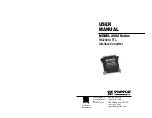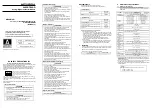
2.0 GENERAL INFORMATION
Thank you for your purchase of this Patton Electronics product.
This product has been thoroughly inspected and tested and is
warranted for One Year parts and labor. If any questions or problems
arise during installation or use of this product, please do not hesitate to
contact Patton Electronics Technical Support at (301)-975-1007.
2.1 FEATURES
• Bi-directional, asynchronous data conversion between RS-232
and TTL
• Supports data rates to 230 kbps
• Two versions available:
Model 2002FC-MT
connects an RS-232 DTE to a TTL DCE
Model 2002FT-MC
connects an RS-232 DCE to a TTL DTE
• Passes TD & RD plus five control signals: CD, DTR, DSR, CTS &
RTS
• Data and control signals independently selectable for
inverting/non-inverting
• Interface powered–no AC required
• RS-232 interface is a DB-25 female, TTL interface is a DB-25 male
2.2 DESCRIPTION
The
Patton Model 2002 RS-232 to TTL Interface Converter
lets
an asynchronous RS-232 device communicate bi-directionally with an
asynchronous TTL device. Supporting data rates up to 230 kbps, the
Patton Model 2002 passes data (TD, RD) plus five control signals (CD,
DTR, DSR, CTS and RTS). In addition, the Patton Model 2002 allows
data and control signals to be independently jumper-selected as
“inverting” or “non-inverting.”
The
Patton Model 2002
is available in two versions: DCE-to-DTE
and DTE-to-DCE. The RS-232 interface is presented on a DB-25
female connector, while the TTL interface is presented on a DB-25
male connector. Deriving power from the data and control signals, the
Patton Model 2002 requires no AC power or batteries for operation.
3
3.0 CONFIGURATION
The Model 2002 is very easy to use. Most applications require no
configuration. Just plug it in and go! However, some TTL circuitry
requires data and/or control signals to be inverted (opposite) from their
normal conditions. Please read the section below to determine if the
default settings will work for you.
3.1 DEFAULT TTL LOGIC LEVELS
Systems represents data signals by alternating between “mark”
(binary “1”) and space (binary “0”) conditions. TTL (Transistor-Transitor
Logic) circuitry normally a represents a “mark” as a voltage between
2.4 and 5.0 Volts, and a “space” as a voltage between 0.4 and 0.4
Volts. By contrast, TTL control signals (RTS, CTS, DSR, DCD and
DTR) are either “active” (between 0.0 and 0.4 Volts), or “inactive”
(between 2.4 and 5.0 Volts). Table 1, below, summarizes the above
information.
Table 1, above, shows the default configuration of the Model 2002.
In most cases no modification is required!!
However, if your TTL
circuitry requires inverted signals for either the data or control signals,
you must change the settings of one or two jumper switches. In order
to change the jumper settings, you must open the case. Please follow
the instructions below to do so.
3.2 OPENING THE CASE
TheJP1 and JP2 jumpers on the Model 2002 are located on the
PC board. To open, insert a small flathead screw driver or similar tool
between the DB-25 female connector and the lip of the case as shown
in Figure 1.
4
Figure 1
: Using a Small Screw Driver to Open the Model 2002 Case
Signal Level
Data Signals
Control Signals
0.0 to 0.4 Volts
space
active
2.4 - 5.0 Volts
mark
inactive
Table 1.
Default TTL Signal Levels
Содержание 2002 Series
Страница 16: ......

































